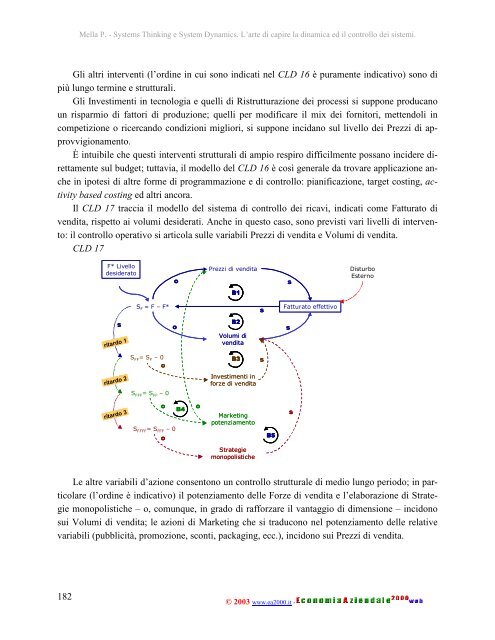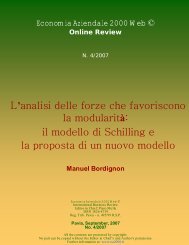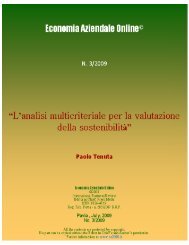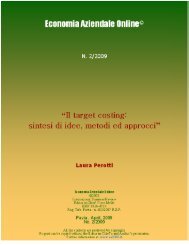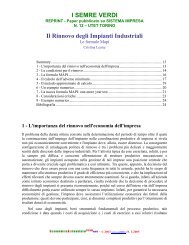Systems Thinking e System Dynamics. L'arte di capire la dinamica ...
Systems Thinking e System Dynamics. L'arte di capire la dinamica ...
Systems Thinking e System Dynamics. L'arte di capire la dinamica ...
- No tags were found...
You also want an ePaper? Increase the reach of your titles
YUMPU automatically turns print PDFs into web optimized ePapers that Google loves.
Mel<strong>la</strong> P. - <strong><strong>System</strong>s</strong> <strong>Thinking</strong> e <strong>System</strong> <strong>Dynamics</strong>. L’arte <strong>di</strong> <strong>capire</strong> <strong>la</strong> <strong>di</strong>namica ed il controllo dei sistemi.Gli altri interventi (l’or<strong>di</strong>ne in cui sono in<strong>di</strong>cati nel CLD 16 è puramente in<strong>di</strong>cativo) sono <strong>di</strong>più lungo termine e strutturali.Gli Investimenti in tecnologia e quelli <strong>di</strong> Ristrutturazione dei processi si suppone producanoun risparmio <strong>di</strong> fattori <strong>di</strong> produzione; quelli per mo<strong>di</strong>ficare il mix dei fornitori, mettendoli incompetizione o ricercando con<strong>di</strong>zioni migliori, si suppone incidano sul livello dei Prezzi <strong>di</strong> approvvigionamento.È intuibile che questi interventi strutturali <strong>di</strong> ampio respiro <strong>di</strong>fficilmente possano incidere <strong>di</strong>rettamentesul budget; tuttavia, il modello del CLD 16 è così generale da trovare applicazione anchein ipotesi <strong>di</strong> altre forme <strong>di</strong> programmazione e <strong>di</strong> controllo: pianificazione, target costing, activitybased costing ed altri ancora.Il CLD 17 traccia il modello del sistema <strong>di</strong> controllo dei ricavi, in<strong>di</strong>cati come Fatturato <strong>di</strong>ven<strong>di</strong>ta, rispetto ai volumi desiderati. Anche in questo caso, sono previsti vari livelli <strong>di</strong> intervento:il controllo operativo si artico<strong>la</strong> sulle variabili Prezzi <strong>di</strong> ven<strong>di</strong>ta e Volumi <strong>di</strong> ven<strong>di</strong>ta.CLD 17F* LivellodesideratooPrezzi <strong>di</strong> ven<strong>di</strong>tasDisturboEsternoB1S F = F – F*sFatturato effettivosritardo 1oB2Volumi <strong>di</strong>ven<strong>di</strong>tasS FF = S F – 0oB3sritardo 2S FFF = S FF – 0Investimenti inforze <strong>di</strong> ven<strong>di</strong>taritardo 3oB4S FFFF = S FFF – 0ooMarketingpotenziamentoB5sStrategiemonopolisticheLe altre variabili d’azione consentono un controllo strutturale <strong>di</strong> me<strong>di</strong>o lungo periodo; in partico<strong>la</strong>re(l’or<strong>di</strong>ne è in<strong>di</strong>cativo) il potenziamento delle Forze <strong>di</strong> ven<strong>di</strong>ta e l’e<strong>la</strong>borazione <strong>di</strong> Strategiemonopolistiche – o, comunque, in grado <strong>di</strong> rafforzare il vantaggio <strong>di</strong> <strong>di</strong>mensione – incidonosui Volumi <strong>di</strong> ven<strong>di</strong>ta; le azioni <strong>di</strong> Marketing che si traducono nel potenziamento delle re<strong>la</strong>tivevariabili (pubblicità, promozione, sconti, packaging, ecc.), incidono sui Prezzi <strong>di</strong> ven<strong>di</strong>ta.182© 2003 www.ea2000.it -


